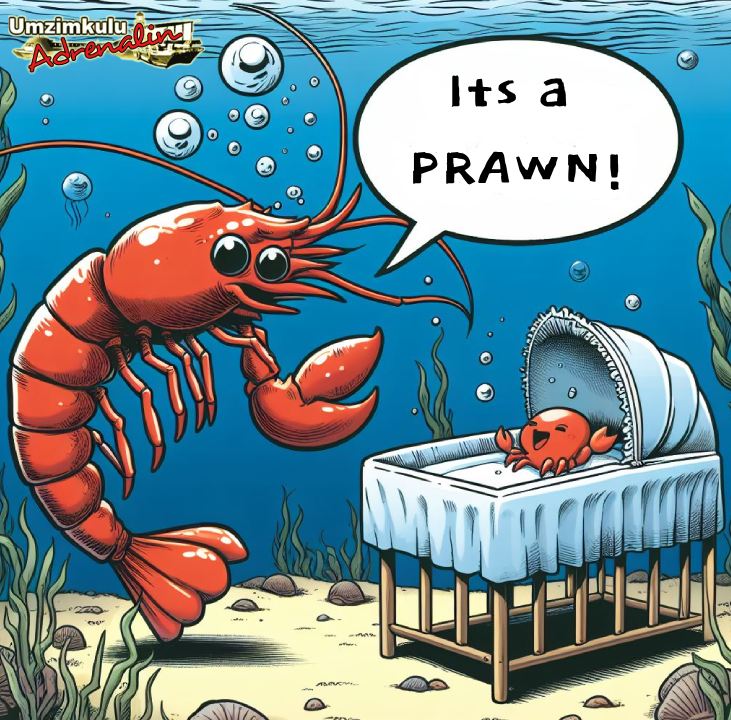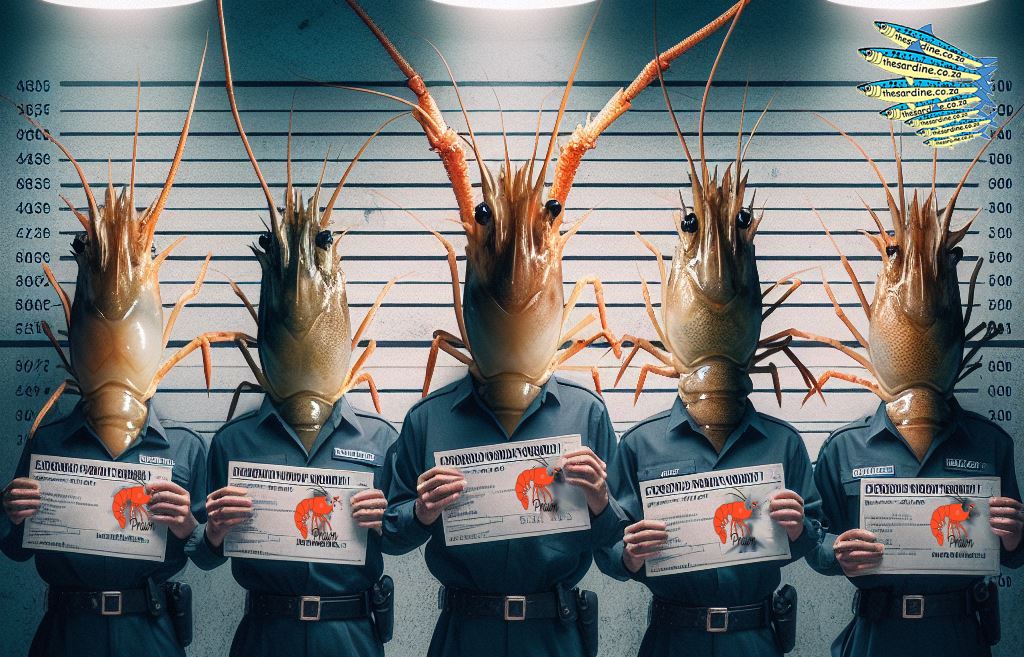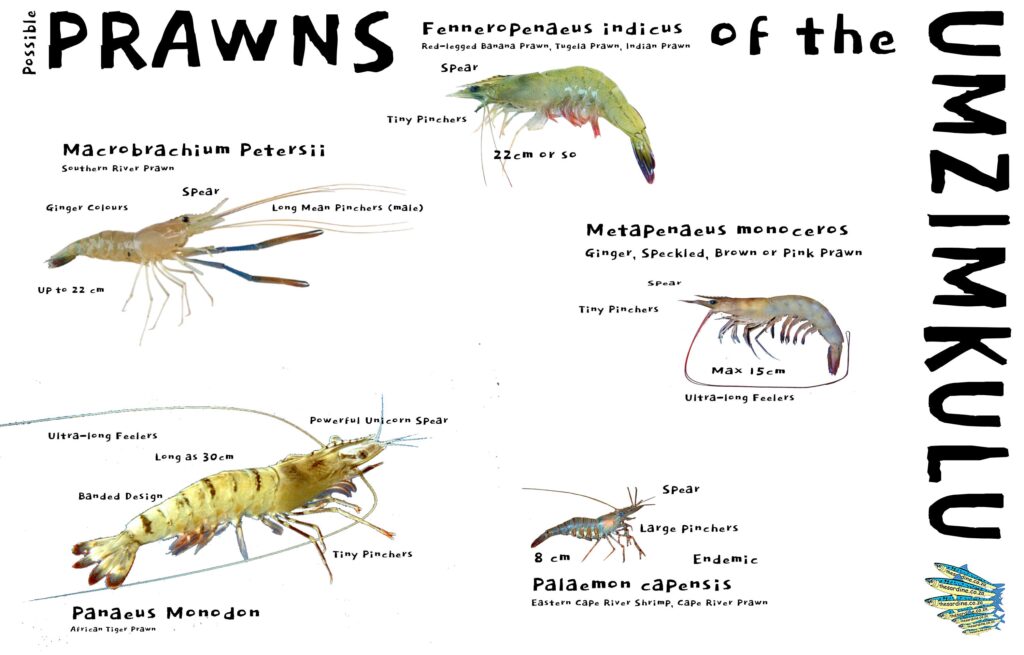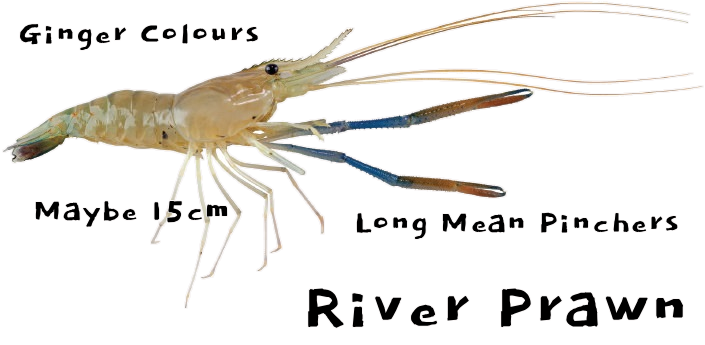
It’s a Prawn!
It’s a Prawn!: for the first season in two years, the prawns are back in the Umzimkulu Estuary! So I went down with a camera and dropped it in. Under the jetty is an ideal spot for prawnies to hide during the day. There were hundreds of the tiniest little guys about 2 to 4 cm long. And a trio of mature adults. That can look really intimidating up close like this.
Enjoy the video and pay close attention to what you might think the identity of the prawns therein…
These estuaries are rich ecosystems that harbour diverse species, including prawns. And shrimp. Yes, there is a difference but we get both models in the Umzimkulu fortunately. The coastal environments where freshwater from rivers meets and mixes with saltwater from the ocean are called transitional zones and are teeming with life. This is where we fish. And learn…
Prawn ID Lineup
The unusual suspects…

After thorough research and sampling, we can with confidence say that all of the following prawns/shrimp, can be found in the Umzimkulu Estuary:
Prawns of the Umzimkulu

Palaemon Capensis – this cute and tasty little prawnie is also known as the Cape River Prawn and thrives in freshwater. It’s commonly found in estuaries and rivers. And is endemic to the Eastern Cape and immediate surrounds. Only gets about 8cm or so. Delicious.
Palaemon Monodon is the big old African Tiger Prawn. These huge prawns actually live out in the ocean most of the time. They breed out deep. But I have them on my underwater cameras, swimming into the estuary with a blue incoming tide. Free swimming and out in the open!
Macrobrachium: Macrobrachium petersii – the river giant prawn prefers brackish water and can tolerate varying salinities. It’s a large and robust prawn species. Macrobrachium rude, another member of this family, also inhabits estuaries and coastal rivers. Both of these guys have seriously long and powerful pinchers up front. And they are prepared to use them! On you! And on each other as they literally duel for territory around the jetty at the Umzimkulu Marina. Females have small front pinchers whereas the males have them longer than their whole bodies. They will bite you!
Metapenaeus monoceros: the highly-sought after Ginger Prawn. Aka Speckled, brown, or pink prawn. Everybody in the estuary is after one of these guys. They also get quite big at about 20cm max.
Fenneropenaeus indicus: The Indian prawn grows to a length of about 22 cm and is is delicious. Known by many names around the world – Indian white , Tugela , white , banana , Indian banana and red leg banana prawn.
We have undertaken to analyse in detail each of our prawn species in a future publication. Watch this space!
In the meantime our guy in the video is…

Southern River Prawn – aka Macrobrachium petersii
And it would seem that his companions were females of the same family. They look much the same but have smaller front pinchers.
Ecological Significance
These prawns play essential roles in our estuarine ecosystems. They serve as chow for various fish, birds, and other aquatic organisms. Additionally, they contribute to nutrient cycling and help maintain ecosystem balance.
For many years the prawns disappeared from the Umzimkulu Estuary. And they evidently still skip years. They might just be a really good indicator of the health of any estuary. And the fact that the prawns disappear completely sometimes, outlines the cyclical nature of our eco-systems.
Down in the Cape, we have recently discovered a forum group who willingly used glyphosate in their very own estuary?! We are investigating further at the moment.
Under no circumstances can we allow any more glyphosate into our estuaries. It affects the entire environment and changes the river bed. Making it unsuitable for the many molluscs, worms and other vital organisms. And prawns…
General Effects on Aquatic Organisms:
Growth and Development: Glyphosate and its major metabolite AMPA (aminomethylphosphonic acid) influence growth and early development in aquatic organisms3.
Oxidative Stress and Antioxidant Enzymes: Glyphosate exposure can lead to oxidative stress, affecting biomarkers and antioxidant enzymes3.
Haematological and Biochemical Plasma Indices: Glyphosate may cause changes in blood parameters and biochemical indices3.
Histopathological Changes: Glyphosate has been associated with histopathological alterations in aquatic organisms3.
The estuaries of South Africa and the world are precious and deserve our protection. Let’s continue to learn, appreciate, and conserve these vital ecosystems!
This article first appeared on the Umzimkulu Adrenalin website.
Affiliated YouTube Channels
https://youtube.com/@thesardinenews
https://youtube.com/@mydotackletalk
https://youtube.com/@waterwoes
https://youtube.com/@Brucifire
Websites
https://brucifire.co.za
https://thesardine.co.za
https://masterwatermen.co.za
https://umzimkuluadrenalin.co.za
https://divingdivassa.co.za
References:
Vivier, L. (2006). Prawn community structure in the subtropical Mfolozi–Msunduzi estuarine system, KwaZulu-Natal, South Africa. ¹.
Collections of freshwater shrimps along the southern coast of South Africa. ².
Prawns – Marine Life – South Africa. ³.
Know your Estuaries – Coast KZN. ?.
Source: Conversation with Bing, 2024/02/27
(1) Prawn community structure in the subtropical Mfolozi–Msunduzi estuarine …. https://www.academia.edu/12460614/Prawn_community_structure_in_the_subtropical_Mfolozi_Msunduzi_estuarine_system_KwaZulu_Natal_South_Africa.
(2) Collections of freshwater shrimps along the southern coast of South Africa. https://journals.co.za/doi/pdf/10.10520/AJA00445096_379.
(3) Prawns – Marine Life – South Africa. https://southafrica.co.za/prawns.html.
(4) Know your Estuaries – Coast KZN. https://www.coastkzn.co.za/themes/estuaries/know-your-estuaries/.
(5) Prawn Farming in South Africa. https://southafrica.co.za/prawn-farming-in-south-africa.html.
(6) 5.1 ESTUARIES – Coast KZN. https://www.coastkzn.co.za/wp-content/uploads/2022/10/KZNSOCR_Section_5.1_1-1.pdf.
The post It’s a Prawn! appeared first on Umzimkulu Adrenalin.
